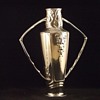Posted 11 years ago
 glasfreund
glasfreund
(37 items)
I have been looking into Heckert art nouveau glasses for some years, convinced that Heckert produced undecorated glass ware finished at the furnace around 1900. Some hints have guided me to Heckert glass. Pazaurek noted Heckert among other well known makers as producer in his book "Moderne Gläser" published c1902 (image left). Jan Mergl assumed Heckert as maker for some types of anonymous productions curating the Passau collection (Passau Glasmuseum, Das Böhmische Glas, Band IV, IV.388, p.222).
The newly discovered pattern books of Glasfabrik Fritz Heckert contain thousands of shapes. The books titeled 400 and 500 contain three sets of patterns numbered with Th (most probably for the manager and designer Otto Thamm). At the end of book 400 are the patterns Th 50 - 100. Also the end of book 500 contains pattens Th 101 - 162 and Th 201 - 250. It might be possible that the numbers TH 1 - 49 were drawn in book 300, which did not survive. Numbers Th 163 - 200 may not exist, as there is only one empty page between Th 162 and 201. Glasses of many, if not all patterns of the Th series can be found with furnace finished decors. The most often decor is the well known "Silberband", mistakenly attributed to Loetz and Kralik in the past.
Besides the Th series also regular numbered patterns in the books can be linked to existing pieces with Silberband and other decors now definitely associated with Fritz Heckert Glasfabrik.
Pattern 496/5 (book 400, page 496, pattern no. 5; see second image) is special. It states "496/5 abgeänderte Form nur für Changeant" (496/5 modified shape for Cangeant only). This shape is a key to the decor name Changeant. And the correspondent glass exists in real! (third image). Now it is safe to name the Silberband decor with its original designation "Changeant". The decor name is not limited to the green color, as vase no. 496/5 does exist in the other "Silberband colors". A collection of ruby red "Changeants" is shown in the image to the right.
































very beautiful!!
Volkmar, thank you so much for sharing your research. It is so fascinating, and wonderful to hear that they found Heckert's pattern books. The green vase you show in your images is gorgeous. My question is that it looks more like a mottled and swirled decor than the vases I typically have seen called Silberbands (such as the red vases in your last image, with more defined silver 'banding'). Is the green vase the Changeant decor specifically? I realize you mention that it comes in other colors, too, but I was just wondering if the name referred to this particular mottled style of the glass, or if it can be applied to all the vases we currently call 'silberbands'? I hope my question makes sense. I am so pleased to learn more about Heckert - thanks again!!
Congratulations on your discoveries!
Pazaurek mentions Caméleon as well. Any thoughts on this?
Nice bit of research, Volkmar - thanks for posting!
Great detective work, Volkmar! I'm curious. Did you run across the shape drawing for this ( http://www.collectorsweekly.com/stories/96321-unusual-heckert-silberband-bronze-mounte ) in the Heckert design book? The mount is so unusual, I can't imagine that it wasn't a special order design.
Congratulations on another job well done.
Thank you all for the nice comments!
@cogito: Your vase is not in the pattern books. There are more pewter mounted vases of this specific decor and color (I call it purple Changeant) which are not in the books - for what reason ever.
@Michelleb007: I am sure Changeant refers to all color variations of the Silberbands, characterized by colorless or colored threads over a spotted ground. The threads are always twisted to kind of spirals. Colors are ruby red, green, yellow, orange (actually a mixture of red and yellow frits), purple (appears blue), bottle-green and they come with variations. The name Silberband (silver band) strongly refers to threads made of glass containing silver. These appear different in different light settings and even different from the making. Some times they look as metallic as platinum, others opal-white with all variations in between. If you look through the glass they appear pale brownish. I may post a few examples later. Another popular version is made of silver yellowish spots and green threads.
Well done!
I was wondering if Changeant and Cameleon aren't actually kind of the same thing.
Thanks for checking, Volkmar, and for the added information! Heckert is finally getting some well deserved attention.
Thank you very much for the additional information on the colors and threads/banding. That makes a lot of sense. Your research is fascinating, and I am looking forward to seeing more Heckert examples in the future!
Nice read..